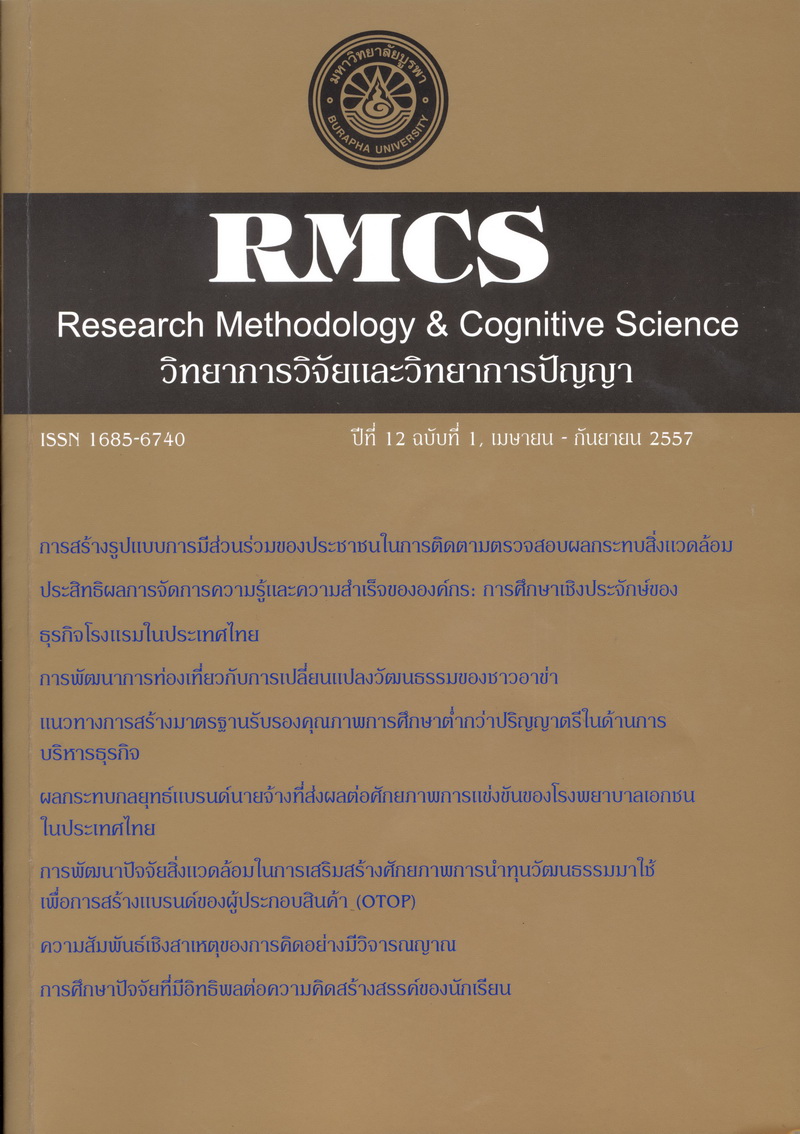การพัฒนาโมเดลความสัมพันธ์เชิงสาเหตุระหว่างเป้าหมายแรงจูงใจใฝ่สัมฤทธิ์การรับรู้สภาพแวดล้อมการเรียนรู้ในห้องเรียนสำหรับชั้นเรียนวิชาศึกษาทั่วไป วิธีการเรียนรู้ และการคิดอย่างมีวิจารณญาณ
Main Article Content
Abstract
การวิจัยนี้มีวัตถุประสงค์เพื่อ (1) ศึกษาลักษณะทั่วไปในด้านเป้าหมายแรงจูงใจใฝ่สัมฤทธิ์ วิธีการเรียนรู้ การรับรู้ สภาพแวดล้อมการเรียนรู้ในห้องเรียนสําหรับชั้นเรียนวิชาศึกษาทั่วไป และทักษะการเรียนแบบการคิดอย่างมีวิจารณญาณ ของผู้เรียน และ (2) ตรวจสอบความสอดคล้องของโมเดลความสัมพันธ์เชิงสาเหตุระหว่างตัวแปรเป้าหมายแรงจูงใจใฝ่ สัมฤทธิ์ วิธีการเรียนรู้ การรับรู้สภาพแวดล้อมการเรียนรู้ในห้องเรียนสําหรับชั้นเรียนวิชาศึกษาทั่วไป และทักษะการเรียน แบบการคิดอย่างมีวิจารณญาณของผู้เรียน กลุ่มตัวอย่างเป็นนิสิตชั้นปีที่ 1 มหาวิทยาลัยศรีนครินทรวิโรฒ ที่เรียนรายวิชา ศึกษาทั่วไป จํานวน 547 คน การวิเคราะห์ข้อมูลใช้สถิติบรรยาย และสถิติวิเคราะห์โมเดลสมการโครงสร้าง ผลการวิจัย ปรากฏว่า ผู้เรียนส่วนใหญ่มีลักษณะการรับรู้สภาพแวดล้อมการเรียนรู้ในห้องเรียนสําหรับชั้นเรียนวิชาศึกษาทั่วไปแบบ ร่วมมือกัน มีเป้าหมายแรงจูงใจใฝ่สัมฤทธิ์แบบมุ่งความรู้ มีวิธีการเรียนรู้แบบผิวเผิน และผู้เรียนมีทักษะการเรียนแบบการ คิดอย่างมีวิจารณญาณในระดับค่อนข้างมาก และโมเดลความสัมพันธ์เชิงสาเหตุที่พัฒนาขึ้นและมีการปรับโมเดลเพิ่มเติมมี ความสอดคล้องกับข้อมูลเชิงประจักษ์ ซึ่งจากโมเดลแสดงให้เห็นถึงอิทธิพลของตัวแปรต่าง ๆ ที่ส่งผลต่อทักษะการเรียน แบบการคิดอย่างมีวิจารณญาณของผู้เรียน ผลการวิจัยนี้ให้ข้อเสนอแนะเพื่อสร้างนวัตกรรมการจัดการเรียนรู้โดยสร้างองค์ ความรู้เพิ่มเติมในการจัดสภาพแวดล้อมการเรียนรู้สําหรับผู้เรียนในรายวิชาศึกษาทั่วไป
Development of a Causal Model of Achievement Goal Orientations in Learning, Perceptions of Learning Environment in a General Education Classroom, and Learning Approaches toward Critical Thinking
Chanut Poondej
Innovative Learning Center, Srinakharinwirot University, Thailand
The purposes of this study were (1) to investigate students’ achievement goal orientations in learning, perceptions of learning environment in a general education classroom, approach to learn, and learning strategies for critical thinking and (2) to validate a causal model of students’ achievement goal orientations in learning, perceptions of learning environment in a general education classroom, and learning approaches affecting their learning strategies for critical thinking with empirical data. The study comprised 547 first year students who enrolled in a general education course at Srinakharinwirot University. Descriptive statistics was employed to describe the data. Structural equation modelling was used to test a hypothetical model. The results indicated that most students (1) perceived the general education classroom learning as a cooperative learning environment, (2) adopted a mastery achievement goal orientation towards learning, and (3) used a surface learning approach. They had relatively high scores for learning strategies indicating critical thinking. Furthermore, a hypothetical model modified on the basis of the observed data showed acceptable fit. The model showed that learning strategies for critical thinking were influenced by students’ achievement goal orientation, their perceptions of learning environment in a general education classroom, and their learning approach. These findings have substantial implications for the design of innovative classroom learning environments in a general education course.
